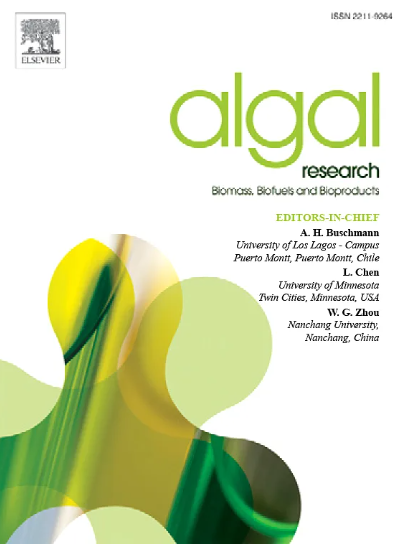纳米银富集平节螺旋藻:对纳米颗粒吸收和生物量积累的影响
IF 4.5
2区 生物学
Q1 BIOTECHNOLOGY & APPLIED MICROBIOLOGY
Algal Research-Biomass Biofuels and Bioproducts
Pub Date : 2025-07-30
DOI:10.1016/j.algal.2025.104253
引用次数: 0
摘要
将纳米银颗粒整合到蓝藻平节螺旋藻生物量中,是一种提高其功能价值的有前途的策略。然而,在有效的纳米颗粒吸收和保存生物量积累之间取得平衡仍然是一个关键的挑战。这项研究调查了两种银纳米颗粒类型——在蒸馏水中通过放电合成(AgNPs)并用碳酸钾(AgNPs K₂CO₃)稳定——对生物质积累、生化组成、氧化应激标志物和纳米颗粒吸收的影响。这两种纳米颗粒类型都能有效地进行生物积累,保留效率高达92%,而不会完全抑制生物合成活性。AgNPs K₂CO₃增强了Arthrospira platensis的生物量积累和抗氧化活性,而这两种纳米颗粒类型都降低了蛋白质和碳水化合物的含量。生物质中的脂质水平取决于纳米颗粒类型及其浓度。值得注意的是,丙二醛水平与对照组相当,表明有效的氧化应激管理。高银吸收与保持氧化还原平衡和可接受的生化参数的结合表明,富含银纳米粒子的Arthrospira platensis生物量,特别是K₂CO₃稳定的生物质,可以被认为是安全和可控的生物技术应用。本文章由计算机程序翻译,如有差异,请以英文原文为准。
Enrichment of Arthrospira platensis with silver nanoparticles: Effects on nanoparticle uptake and biomass accumulation
The incorporation of silver nanoparticles into cyanobacterium Arthrospira platensis biomass is emerging as a promising strategy to enhance its functional value. However, achieving a balance between efficient nanoparticle uptake and the preservation of biomass accumulation remains a key challenge. This study investigated the effects of two silver nanoparticles types - synthesized via electrical discharge in distilled water (AgNPs) and stabilized with potassium carbonate (AgNPs K₂CO₃) - on biomass accumulation, biochemical composition, oxidative stress markers, and nanoparticle uptake. Both nanoparticle types were effectively bioaccumulated, with retention efficiencies reaching up to 92 %, without entirely suppressing biosynthetic activity. AgNPs K₂CO₃ enhanced Arthrospira platensis biomass accumulation and antioxidant activity, while both nanoparticles' types reduced protein and carbohydrate content. Lipid levels in the biomass varied depending on nanoparticle type and their concentration. Notably, malondialdehyde levels remained comparable to the control, suggesting effective oxidative stress management. The combination of high silver uptake with preserved redox balance and acceptable biochemical parameters indicates that Arthrospira platensis biomass enriched with silver nanoparticles, particularly K₂CO₃-stabilized, can be considered for safe and controlled biotechnological applications.
求助全文
通过发布文献求助,成功后即可免费获取论文全文。
去求助
来源期刊

Algal Research-Biomass Biofuels and Bioproducts
BIOTECHNOLOGY & APPLIED MICROBIOLOGY-
CiteScore
9.40
自引率
7.80%
发文量
332
期刊介绍:
Algal Research is an international phycology journal covering all areas of emerging technologies in algae biology, biomass production, cultivation, harvesting, extraction, bioproducts, biorefinery, engineering, and econometrics. Algae is defined to include cyanobacteria, microalgae, and protists and symbionts of interest in biotechnology. The journal publishes original research and reviews for the following scope: algal biology, including but not exclusive to: phylogeny, biodiversity, molecular traits, metabolic regulation, and genetic engineering, algal cultivation, e.g. phototrophic systems, heterotrophic systems, and mixotrophic systems, algal harvesting and extraction systems, biotechnology to convert algal biomass and components into biofuels and bioproducts, e.g., nutraceuticals, pharmaceuticals, animal feed, plastics, etc. algal products and their economic assessment
 求助内容:
求助内容: 应助结果提醒方式:
应助结果提醒方式:


